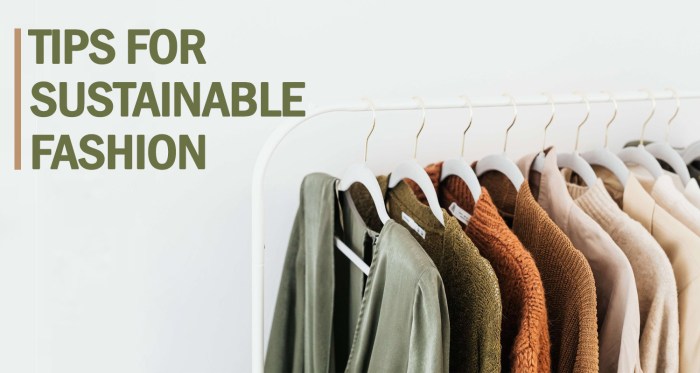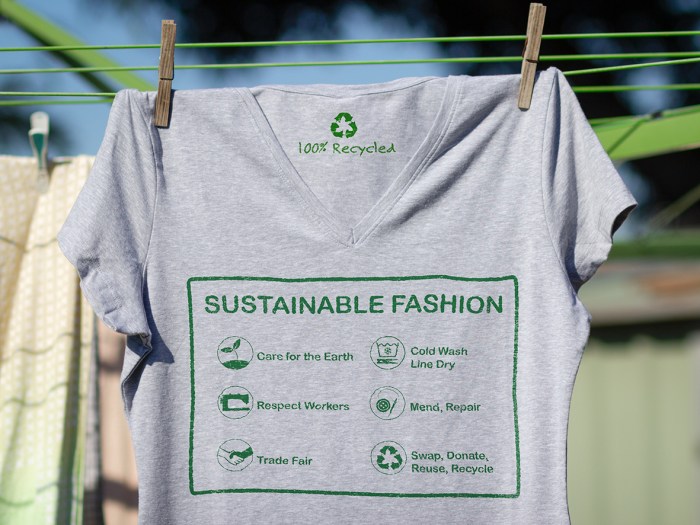With sustainable fashion tips at the forefront, get ready to step into a world where style meets sustainability. From choosing quality pieces to embracing eco-friendly fabrics, this guide is your ticket to a fashionable and planet-friendly wardrobe.
Are you ready to rock your outfits while saving the planet? Let’s dive into the world of sustainable fashion tips and make a difference, one stylish choice at a time.
Importance of Sustainable Fashion
Fast fashion has a detrimental impact on the environment due to its high consumption of resources, water, and energy, leading to increased pollution and waste generation. The production of cheap and trendy clothing often involves the extensive use of harmful chemicals, exploitation of labor, and contributes significantly to carbon emissions, deforestation, and water pollution.
Benefits of Adopting Sustainable Fashion Practices
Adopting sustainable fashion practices can help reduce the negative environmental impact of the fashion industry. It promotes ethical manufacturing processes, the use of eco-friendly materials, and fair labor practices. By choosing sustainable fashion options, individuals can support brands that prioritize environmental sustainability and contribute to reducing waste and pollution.
Key Reasons Why Sustainable Fashion is Essential
Sustainable fashion is essential for the future of the planet as it helps in conserving natural resources, minimizing waste generation, and promoting a more circular economy. By shifting towards sustainable fashion practices, we can work towards reducing carbon footprint, protecting ecosystems, and creating a more sustainable and ethical fashion industry for generations to come.
Tips for Building a Sustainable Wardrobe
Building a sustainable wardrobe involves making conscious choices that prioritize quality, longevity, and ethical practices. By focusing on timeless pieces and supporting sustainable brands, you can reduce your environmental impact and contribute to a more sustainable fashion industry.
Choose Quality Over Trends, Sustainable fashion tips
When building a sustainable wardrobe, opt for high-quality pieces that are made to last. Instead of following fast fashion trends that quickly go out of style, invest in classic items that you can wear for years to come. Look for well-made garments with durable materials and timeless designs that won’t go out of fashion.
Repurpose, Repair, Recycle
To extend the lifespan of your clothing items, consider repurposing or repairing them instead of discarding them. Get creative and find new ways to style old pieces, or learn basic sewing skills to mend tears and fix loose seams. Additionally, donate or recycle clothing that you no longer wear to reduce waste and give your clothes a second life.
Support Ethical Brands
Research and support brands that prioritize ethical and sustainable practices in their production processes. Look for labels that use eco-friendly materials, pay fair wages to workers, and have transparent supply chains. By choosing to support these brands, you can help promote sustainability in the fashion industry and make a positive impact on the environment.
Sustainable Fabric Choices: Sustainable Fashion Tips

When it comes to sustainable fashion, choosing the right fabrics is crucial in reducing environmental impact. Opting for eco-friendly materials like organic cotton, linen, and Tencel can make a significant difference in creating a more sustainable wardrobe.
Characteristics of Eco-Friendly Fabrics
- Organic cotton: Grown without the use of harmful pesticides or synthetic fertilizers, organic cotton is better for the environment and for the farmers who cultivate it.
- Linen: Made from the flax plant, linen is a durable and biodegradable fabric that requires less water and pesticides to grow compared to conventional cotton.
- Tencel: Also known as lyocell, Tencel is a sustainable fabric made from wood pulp. It is produced in a closed-loop process that minimizes waste and reduces environmental impact.
Environmental Impact Comparison
- Synthetic fabrics: Materials like polyester and nylon are derived from petroleum-based sources and have a significant carbon footprint. They also contribute to microplastic pollution in oceans.
- Natural fibers: Fabrics like organic cotton, linen, and Tencel are biodegradable, require less water and energy to produce, and are generally more eco-friendly than synthetic alternatives.
Sustainable Fabric Alternatives
- For activewear: Look for fabrics like recycled polyester, organic cotton, or Tencel blends that offer both performance and sustainability.
- For everyday wear: Choose clothing made from organic cotton, linen, hemp, or Tencel for comfortable and environmentally friendly options.
- For formal occasions: Opt for garments made from Tencel or peace silk, which are luxurious and sustainable choices for special events.
Sustainable Fashion Practices

In the realm of sustainable fashion practices, there are key concepts and actions that can significantly contribute to a greener and more ethical industry. Let’s delve into the importance of circular fashion, reducing water and energy consumption, and extending the lifespan of clothing.
Circular Fashion
Circular fashion is a concept that focuses on creating a closed-loop system in the fashion industry. This means designing, producing, and consuming clothing in a way that minimizes waste and maximizes the lifespan of products. By embracing circular fashion principles, brands can reduce their environmental impact and promote sustainability.
Reducing Water and Energy Consumption
The fashion industry is notorious for its high water usage and energy consumption, contributing to pollution and resource depletion. To combat this, it’s crucial for brands to implement practices that reduce water usage during production processes and decrease energy consumption in manufacturing facilities. By adopting sustainable practices, such as using eco-friendly dyes and energy-efficient machinery, the industry can lessen its environmental footprint.
Extending Clothing Lifespan
One effective way to promote sustainability in fashion is by extending the lifespan of clothing items. This can be achieved through proper care and maintenance practices, such as washing garments in cold water, air-drying instead of using a dryer, and repairing or upcycling old clothes instead of discarding them. By taking care of our clothes and making them last longer, we can reduce the need for constant consumption and minimize textile waste.